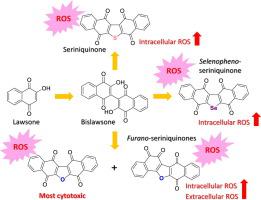Bioorganic & Medicinal Chemistry Letters ( IF 2.7 ) Pub Date : 2022-09-17 , DOI: 10.1016/j.bmcl.2022.128992 Haruna Nagao 1 , Masayuki Ninomiya 2 , Hodaka Sugiyama 1 , Atsuya Itabashi 1 , Kaho Uno 1 , Kaori Tanaka 3 , Mamoru Koketsu 1

|
Quinones are widespread in plants, animals, insects, and microorganisms. Several anticancer agents contain quinone structures as critical parts to show remarkable potential and distinctive modes of actions. The purpose of this study was to investigate the structure–activity relationships of microbial quinones and their derivatives as anticancer agents. A series of p-terphenylquinone and seriniquinone derivatives were therefore prepared. Treatment of the synthesized quinones possessed antiproliferative activity on human leukemia HL-60 cells in a dose-dependent fashion. In addition, seriniquinone derivatives elevated cellular reactive oxygen species (ROS) levels, thereby triggering the ensuing apoptotic events. Our findings emphasize the excellent potential of seriniquinone derivatives as redox cycling-induced ROS-modulating anticancer agents.
中文翻译:

对三苯醌和丝氨酸醌衍生物作为活性氧调节剂的比较分析
醌广泛存在于植物、动物、昆虫和微生物中。几种抗癌剂含有醌结构作为关键部分,显示出显着的潜力和独特的作用模式。本研究的目的是研究微生物醌及其衍生物作为抗癌剂的结构-活性关系。由此制备了一系列对三联苯醌和丝氨酸醌衍生物。合成醌的处理对人白血病 HL-60 细胞具有剂量依赖性的抗增殖活性。此外,丝氨酸醌衍生物会升高细胞活性氧(ROS)水平,从而引发随后的细胞凋亡事件。我们的研究结果强调了丝氨酸醌衍生物作为氧化还原循环诱导的 ROS 调节抗癌剂的巨大潜力。



























 京公网安备 11010802027423号
京公网安备 11010802027423号